



I’m grateful to WordPress for putting together yearly blog reports. Breakfast in Scarborough‘s 2012 results can be viewed here!
A visit to “The House in the Woods: Magical Tales of the Brothers Grimm” revealed the ways that Jacob and Wilhelm Grimm’s Children’s and Household Tales (1812) have evolved over the centuries, soaked into the very bones of narrative structures, and remain alive to this day.
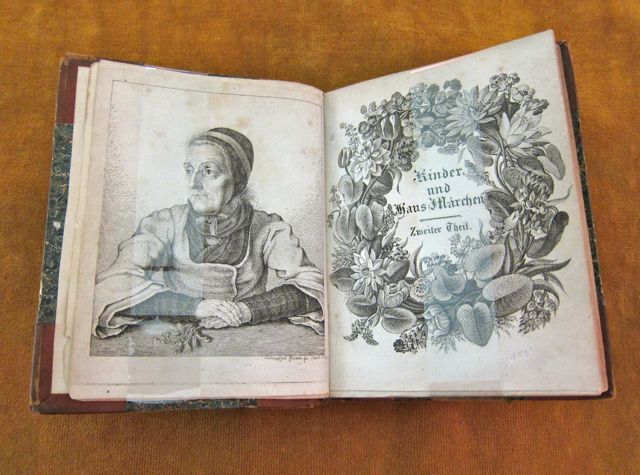
Martha Scott, the curator of this exhibit at the Osborne Collection, generously took the time to walk me through the collection of illustrations, pop-up books, and art that she had gathered to celebrate the 200th anniversary of Children’s and Household Tales. During the tour, I appreciated Ms. Scott’s extensive knowledge of the different versions of the tales and her witty engagement with the illustrations.
For background information, Scott supplied me with a copy of the notes that rested in plastic sleeves on the display cases.

From a very young age, the phrase “The Brothers Grimm” has captivated me, and when I see it in my mind’s eye, I visualize the letters G-R-I-M-M in mahogany-inked calligraphy with extravagant loops like twisted roots for the downward swoops of the “r” and double m’s.
In addition to the distinctive twin m’s, it is possible that the romance of the name is in the word order. Whereas “the Grimm brothers” sounds like a family singing act from Nashville, The Brothers Grimm could independently serve as the title of an ancient fairy tale that stars two solemn brothers who live in a dark forest cottage and spin tales by a hearth on winter evenings.
The real Jacob and Wilhelm, scholars with an interest in preserving oral history, most likely did not personally recite fairy tales around hearths in cottages. However, the imaginative illustrations I saw in “The House in the Woods” left the mystique of the Brothers Grimm intact; the more I learned, the more enchanting the stories became.





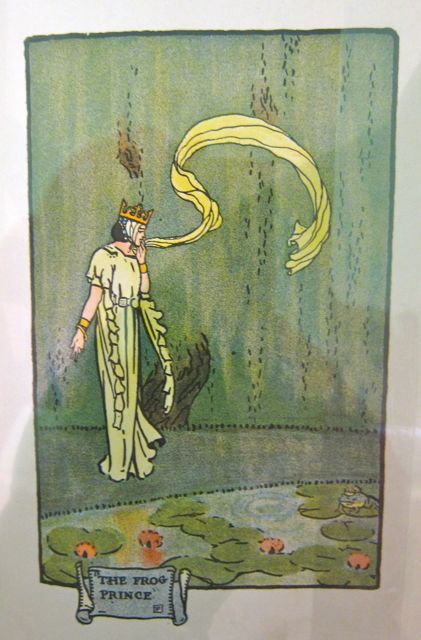






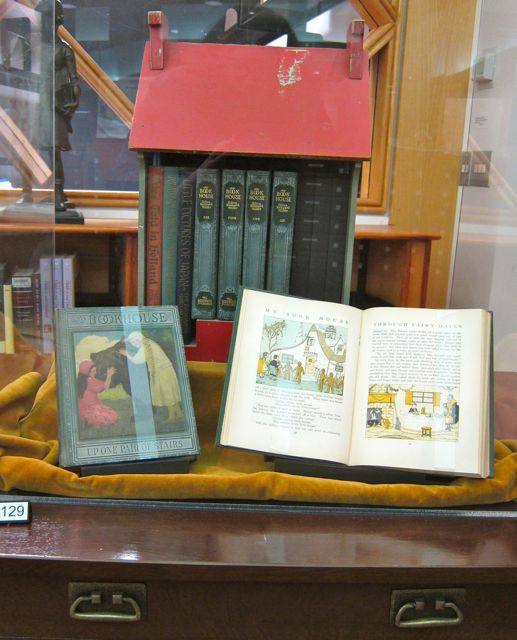
Thank you Martha Scott, Leslie McGrath, and the Osborne Collection for an enriching afternoon in the magical company of the Brothers Grimm! Your book house is a jewel worthy of the finest scholars in the land!
Before I took Drawing 1 at the Toronto School of Art in 2012, I thought I was hopeless at drawing. Even though I had been making collage and textile art for six years, I didn’t feel entitled to call myself a “real” artist because I lacked basic drawing skills.
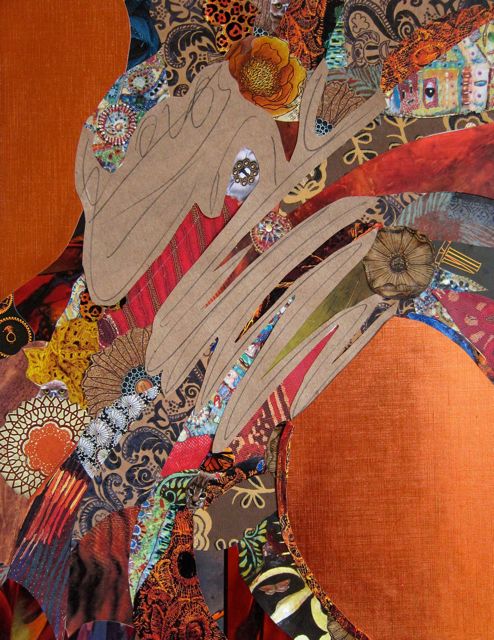
With very little formal training in art, I wanted to address the gaps in my knowledge that held me back from stretching into three dimensions. It was also time to overcome the limiting “I can’t draw!” belief.
On the first day of my TSA evening class, our instructor, Paul Turner, boldly asserted that anyone who could hold a pencil could learn how to draw. I thought to myself, “I hope I don’t prove him wrong!”
As an adult educator myself, I know how important it is convince students to move beyond negative assessments of their abilities. Comparing my skills from the first week to the final week of drawing instruction, I can happily report that the only thing I proved wrong was my self-doubt.
To thank Paul and encourage anyone who wants to learn a new skill, I offer this illustrated blog post as evidence that if I could learn to draw at the age of 43, then others most certainly can too!
 In the first two weeks, our class focused on the humble yet crucial box in one-point and two-point perspective, in addition to the equally essential ellipse. Paul encouraged us to “get comfortable with non-parallels” such as a box resting at a different angle from the table it’s sitting upon. However, I was remarkably and deeply uncomfortable with non-parallels.
In the first two weeks, our class focused on the humble yet crucial box in one-point and two-point perspective, in addition to the equally essential ellipse. Paul encouraged us to “get comfortable with non-parallels” such as a box resting at a different angle from the table it’s sitting upon. However, I was remarkably and deeply uncomfortable with non-parallels.
In fact, I was actively alarmed when Paul stacked six books on top of each other and suddenly shifted all of their spines into different angles. How could I possibly draw that pile? I was barely adept at boxes floating in space, and my ellipses looked like squashed peaches in the mud.
Imagine my discomfiture when a variety of boxes on tables greeted us in week three. I had a drawing board, paper, and a skewer in my hand to gage proportions but little clue how to use it. (There was a reason why I scored low on spatial-relation skills on standardized tests in junior high).
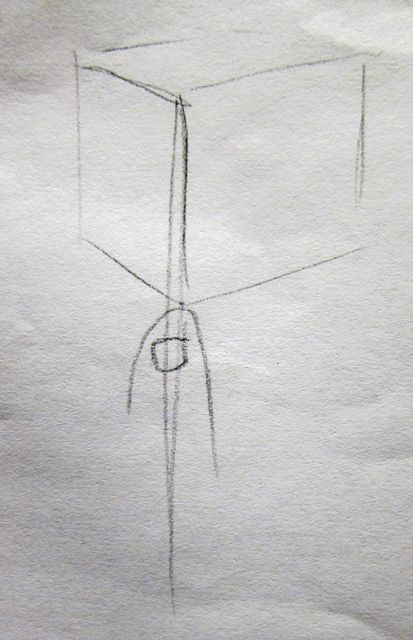 Paul had demonstrated the skewer technique, and he even drew me a picture of a thumb holding a skewer next to a box, but I still felt hopelessly out of my depth. To my horror, I was actually close to tears!
Paul had demonstrated the skewer technique, and he even drew me a picture of a thumb holding a skewer next to a box, but I still felt hopelessly out of my depth. To my horror, I was actually close to tears!

Though measuring proportions was difficult, our instructor exhorted us not to give up. A quick comparison of the drawings above and below bears testimony to the fact that this skill became much easier for me.

In week four, I loved the opportunity to “respond to the total form with one line” and build a “relationship of trust with (my) eye, hand, and mind” (Paul Turner). The total form was a male model who changed poses frequently, and the rapid shifts pushed us to draw from “head to toe, boom, one line!”
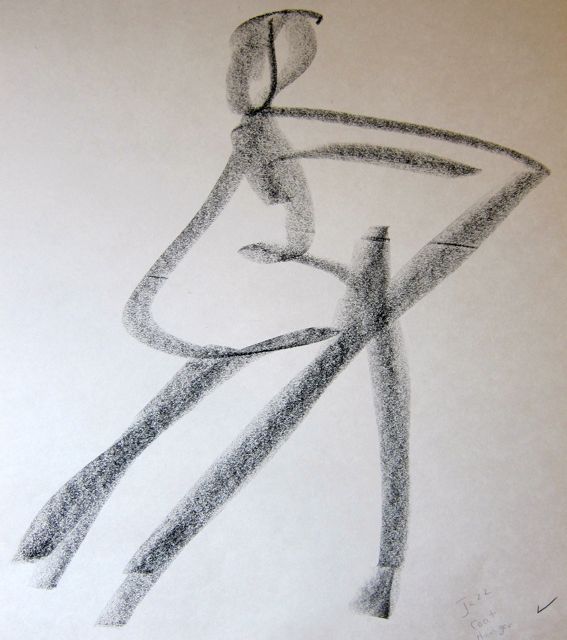


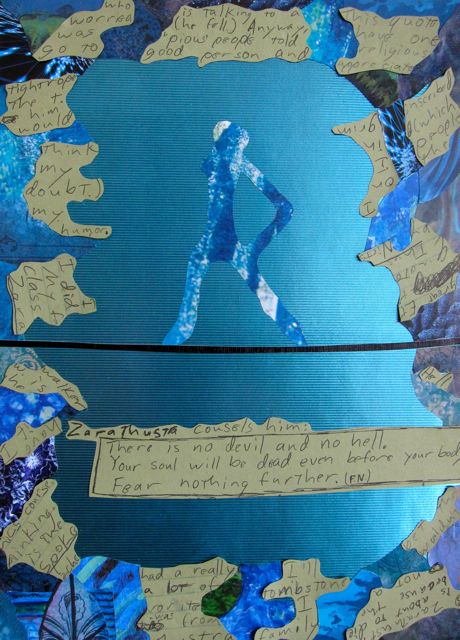

The looseness and freedom of this gesture exercise lifted my spirits after the previous week’s disappointment with myself. Many of my sketches seem to express this joy.


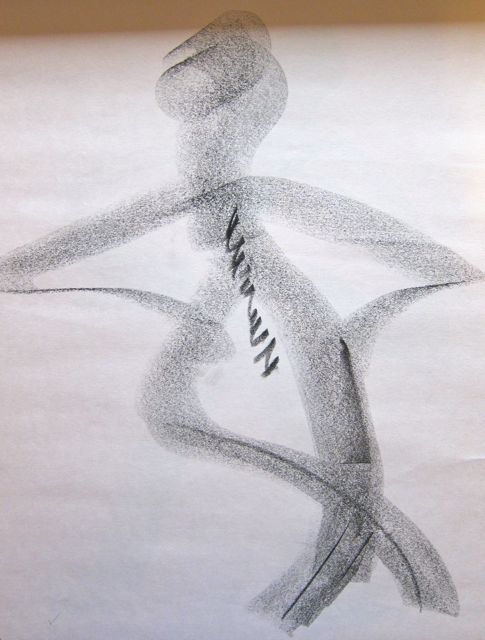
In week five, we considered “how objects behave in space.” I liked the challenge of truly looking at a lantern, a bottle of dish detergent, and a lampshade to determine proportion, shape, and line. I also greatly appreciated Paul’s advice to be in the moment while engaged in drawing: “Don’t focus on where you think you should be (skill-wise) or what your drawing should look like. Be here now!”
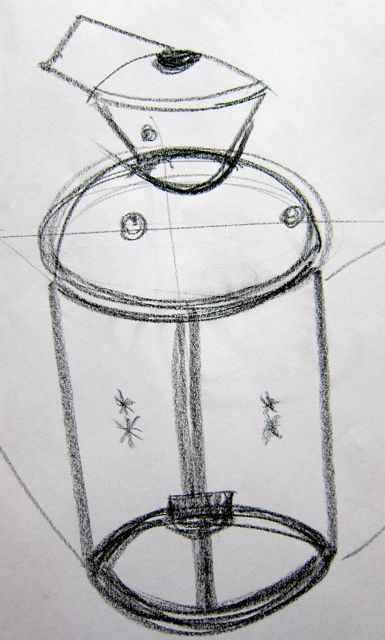 The following week, I learned to pay more attention to the spaces between objects. Our task was to “go after” the shapes created in the gaps between items such as a chair, a goblet, or a sled propped up together on a table. We used white charcoal on colored paper to depict the negative space, allowing the objects to take form from the absence of charcoal.
The following week, I learned to pay more attention to the spaces between objects. Our task was to “go after” the shapes created in the gaps between items such as a chair, a goblet, or a sled propped up together on a table. We used white charcoal on colored paper to depict the negative space, allowing the objects to take form from the absence of charcoal.

It was the objects’ turn to live in the gaps and let so-called empty space take center stage for a change. Why should positive, filled-up space get all the attention when so many fascinating patterns are waiting to be noticed in the liminal places, the edges of objects, and the sea of animated air between them? I loved the radical shift in visual and conceptual perspective that the lesson in negative space inspired.
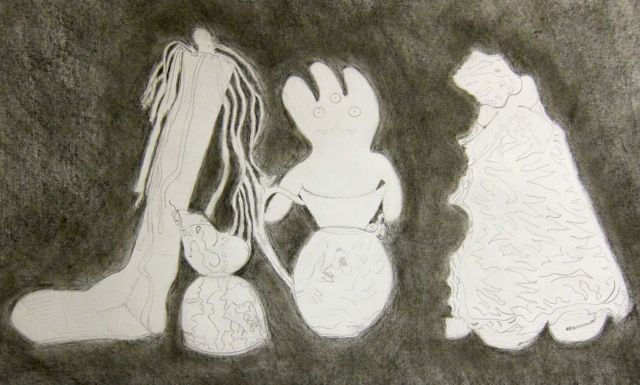

 During week seven’s still-life exercise with two objects, I became very aware of the lovely negative-space shape made by the inside of my grandmother’s silver teapot’s handle, something I might not have noticed prior to the class. As I gazed at the teapot and a green vase from TSA’s closet of diverse objects, Paul suggested, “Let the shape lead you to the line.”
During week seven’s still-life exercise with two objects, I became very aware of the lovely negative-space shape made by the inside of my grandmother’s silver teapot’s handle, something I might not have noticed prior to the class. As I gazed at the teapot and a green vase from TSA’s closet of diverse objects, Paul suggested, “Let the shape lead you to the line.”
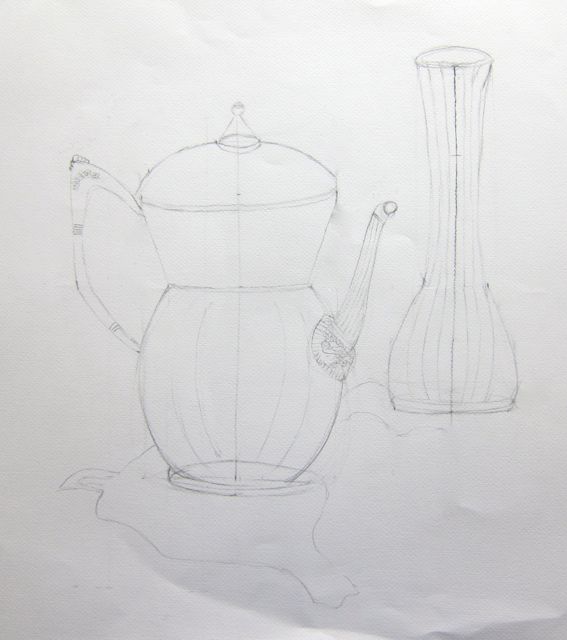
On the eighth class, we had a new model, and Paul instructed us to “build a height and width for the form and then plant a shoulder.” I liked the use of the verb “to plant” in a drawing context because it implied bold, purposeful action, a deliberate sowing of a seed from a burlap bag, a strong line from which something new can grow.

Planting the first shoulder of the form is an act of bravery, a commitment that changes a blank scroll of paper into a potential drawing. The first line transforms an idea into artistic reality, the abstract to the concrete, and fear-paralysis (“Will the line be perfect?”) into definitive action.
 Value was week nine’s topic, and I struggled to get my head around the terminology and grapple with the sphere resting in front of me on a draped table. At one point, I sighed, “Vanquished by a styrofoam ball!”
Value was week nine’s topic, and I struggled to get my head around the terminology and grapple with the sphere resting in front of me on a draped table. At one point, I sighed, “Vanquished by a styrofoam ball!”

I was disappointed in my value drawing even though I managed to improve it somewhat. However, I did like this artistic and psychologically-applicable advice from Paul: “Deal with the dark side of the form first and then work your way into the light.”
In week ten (our last week), we had the opportunity to do sustained drawings of another model and integrate what we’d learned about proportion, shape, gesture, negative space, and line. I also learned some new phrases to describe the long line of the body from shoulder to hip: “the line of action, the bow of the torso, and the C-curve.” I enjoyed thinking in terms of active lines. These lines are alive, humming with tension like an archery bow and curved like fruit in a bowl.
 Even though I had trouble visualizing the planes of the body and understanding what Paul meant when he said, “Let the interior shapes guide you the exterior,” by the end of the evening I had two sketches I particularly liked.
Even though I had trouble visualizing the planes of the body and understanding what Paul meant when he said, “Let the interior shapes guide you the exterior,” by the end of the evening I had two sketches I particularly liked.

 Reflecting on my experience as a novice student of drawing, I am very grateful for such a stimulating class that taught me to have faith in my learning potential. I especially appreciate the invitation to look at objects, space, form, and light in fresh ways. What a gift to an artist and a writer!
Reflecting on my experience as a novice student of drawing, I am very grateful for such a stimulating class that taught me to have faith in my learning potential. I especially appreciate the invitation to look at objects, space, form, and light in fresh ways. What a gift to an artist and a writer!


Thank you, Paul, for taking me on a journey from perceived hopelessness to confidence in a developing skill!
Two hours after Judy Lysy’s talk, my throat still carries its impact, an ache weighted with gratitude for this 84-year-old great-grandmother’s bravery. Ms. Lysy’s physical presence in Locke Library’s program room testified to a beautiful fighting spirit before she even said a word.
Before the testimony started, I looked up some biographical facts in the booklet “Culture of Memory” published for the 32nd Annual Holocaust Education Week: “Judy Lysy was born in Kosice, Czechoslovakia, in 1928. She lived with her parents, sister and grandmother. In March 1944, Judy and her family were deported to Auschwitz-Birkenau and from there to various slave labour camps. She was liberated in May 1945, by the US army. She immigrated to Canada, in 1952, with her husband and daughter” (page 32).
I was glad for the informative booklet, but nothing can compare to listening to a survivor tell her story in person. When Judy occasionally leaned on her cane or wiped her eyes with a tissue, these simple gestures found a way into my heart-memory that letters on a page cannot easily reach.
I heard the pain in her voice when she remembered that not a single one of her Christian neighbours made an attempt to protest or even look out of their windows when Judy’s family was being marched to the ghetto. And the spoken narrative provided more images that made history shockingly real:
The feathered cap of the gendarme who came to take the family to the ghetto. Judy’s grandmother praying in the cattle car for God to intervene. The brutal shearing of Judy’s ribbon-tied pigtails after she arrived at Auschwitz. The German guard eating his lunch of bread and meat with 45 inmates watching him intently, waiting for him to drop a piece of rind.
I’ll never forget Judy’s description of a tank smashing through the fence of the last of five concentration camps that she and her sister and mother endured: “An African-American man looked out from the tank and said, ‘We are the Army of the United States of America!'” Until that point in the talk, her voice had been steady, but it broke when she started to say the first part of the name of my home country. She cried through the pauses she made between “the United . . . States . . . of . . . America,” and the release of powerful emotions in a November 2012 talk seemed to mirror the beginning of release from horror in May 1945.
I’ve never felt prouder to be an American than when Judy Lysy made me see and feel the meaning of liberation. (Barack Obama’s election wins have created a similar pride). I felt the traumatized survivor’s cautious relief, her gratitude for the way the Americans provided baths and “pablo” (baby food) for the survivors, one of the few foods their stomachs could tolerate after long periods of starvation.
I was very proud of Canada, too, when Judy spoke of how its acceptance of immigrants and refugees from all over the world actually restored her faith in God: “I love Canada! Living here with people of every colour and religion, I felt free to be me. And my children could go to any school they wanted.”
She leaned forward to address the two classes of grade sevens in attendance and said, “I want to give you some advice. When you grow up, vote for a government that protects minorities. I’m eighty-four years old and I know without a doubt that we all have hearts. We all have souls.”
Today I’m thankful for Judy Lysy and her willingness to share her heart, soul, and exquisite wisdom. Thanks to her generosity, I take her story with me into the world.
I was lucky to attend Emily Tinkler’s free Altered Books workshop at S. Walter Stewart Library, where more than a dozen participants eagerly listened to Emily describe how to fold, cut, and poke pages with an awl to turn an old book with a sewn binding into a work of art.

I had been given an out-of-date computer book to use for the workshop, and I soon went to work folding the pages to create an accordion shape. I was inspired by the examples that Emily had brought to show us, especially the one in which wire and ribbon rioted through the pages of a former book.
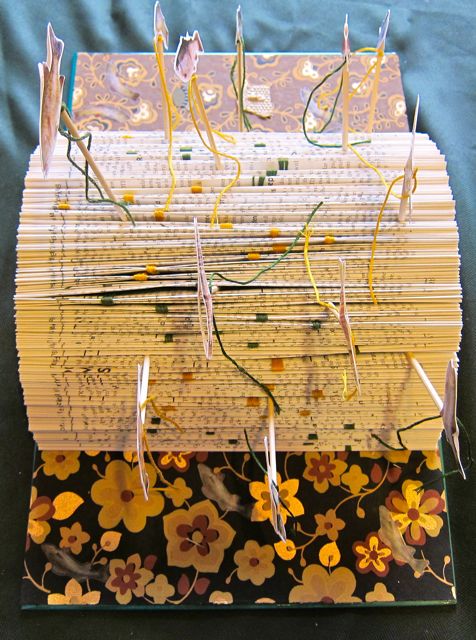
After the session, I took my unfinished piece home, where it sat on a table mutely calling out for something to spring from the folds of paper. Meanwhile, I continued sewing clumps of paper together with saffron and fern green thread.

A trip to the sticker aisle in an art store supplied me with the missing element. Fish! When I saw the fish collection, they seemed to want to be flying out of a book.
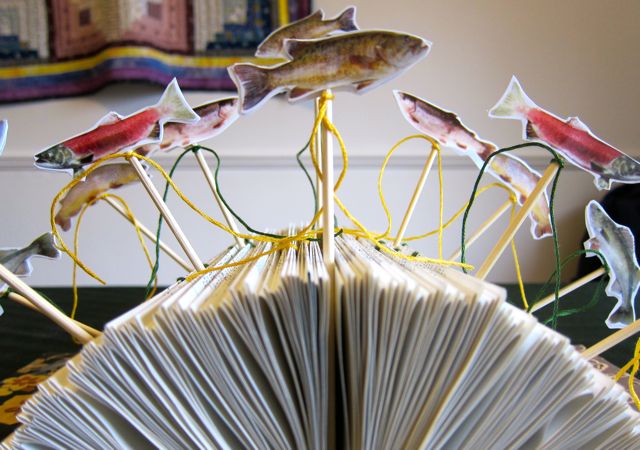
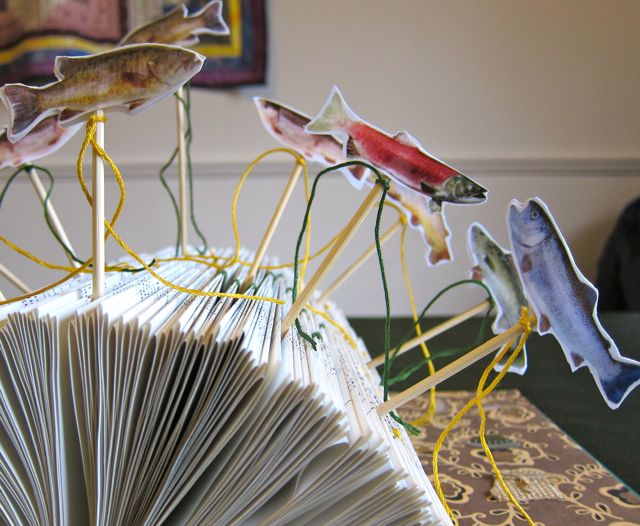
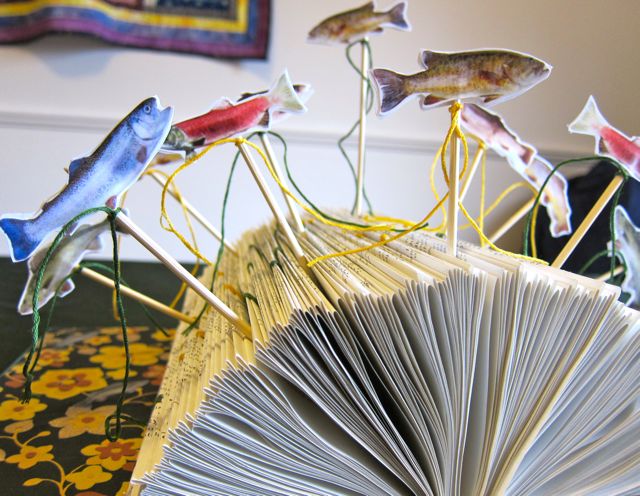

I glued double-images of the fish stickers together, and then I cut twelve skewers into varying sizes before affixing the energetic yet dignified creatures to them. As as penultimate touch, I tied short lengths of the saffron and green thread around each skewer. Finally, I added stickers to the decorated inside covers of the book. And that’s the story of Flying Bookfish!
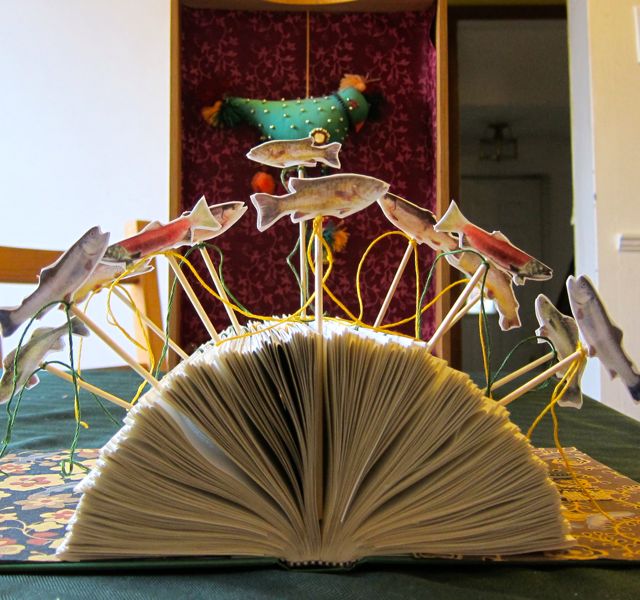
Last year I visited the Textile Museum of Canada courtesy of a library Map Pass. I enjoyed the experience so much that I returned last week just in time to see Dreamland: Textiles and the Canadian Landscape before the exhibit ended.
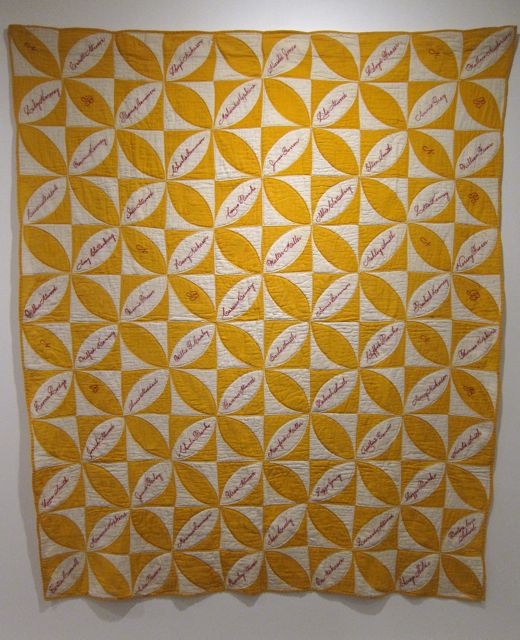
Fascinating art and artifacts populated Dreamland in every direction, almost overwhelming me with visual delight. I loved the hooked rugs holding memories of the lost farm of a New Brunswick couple (“The Gagetown Hookers”) and the remarkable examples of ordinary nineteenth-century clothing.


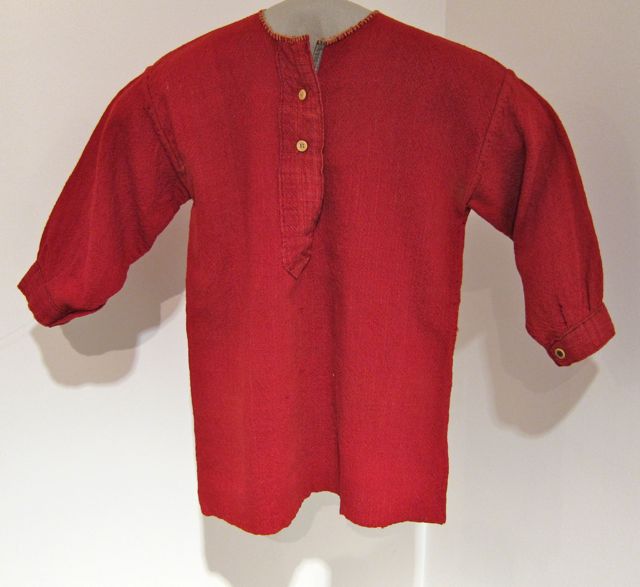

The quilts and samplers reminded me of my grandmother Raine, a beautiful textile artist who knitted a pink poncho with pearl buttons for my Barbie and sewed doll clothes for Her Barbiness, too. Grandma’s favorite quilt pattern was log-cabin, a very disciplined form, so I wonder what she would have made of the crazy quilt I saw in permanent exhibit one floor below.



Even before I knew it was the work of a loving Canadian grandmother, I was drawn to a display of a doll’s complete Red River winter outfit. I also learned from the explanatory text that Anna McLeod Gilmor “would make a doll’s dress as a Christmas present for Margaret (her granddaughter).” She did this “each Christmas from 1945-1950.” Decades later, Margaret Johnson donated these doll clothes to the Textile Museum of Canada.

In addition to the poignant textile legacy of an awesome grandmother, the exhibit that affected the most strongly was Michael Snow’s “Solar Breath/Northern Caryatids.” Snow’s cinematic illusion of a window in a house off the coast of Newfoundland was so effective that I thought it was real.

The sound of the wind pulled me into the darkened viewing room and I was hooked. Although chairs were available, I settled down on the carpet to better surrender to the meditative peace of a film in which the star actor was the wind flapping the curtains, offering brief revelatory glimpses of a woodpile, solar panel, trees, and the Atlantic Ocean

TPL and Map Pass, thank you for giving me the opportunity to experience Solar Breath, marvel at quilts, sashes, long underwear, dresses, rawhide stuffed animals, and a camel cover from Turkemenistan!
 Coverlet, John Campbell, Ontario, c. 1880
Coverlet, John Campbell, Ontario, c. 1880
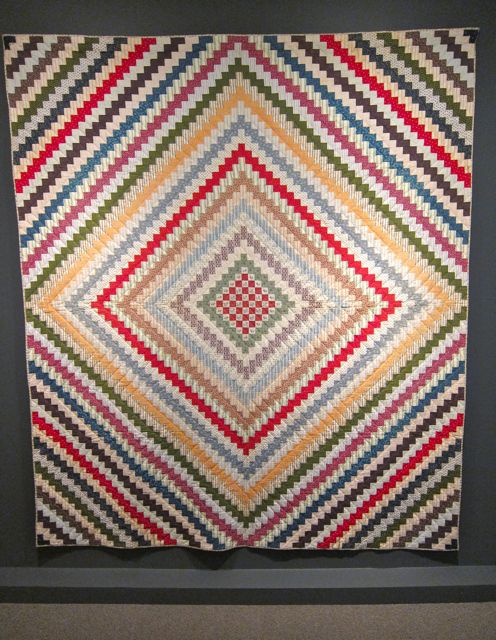
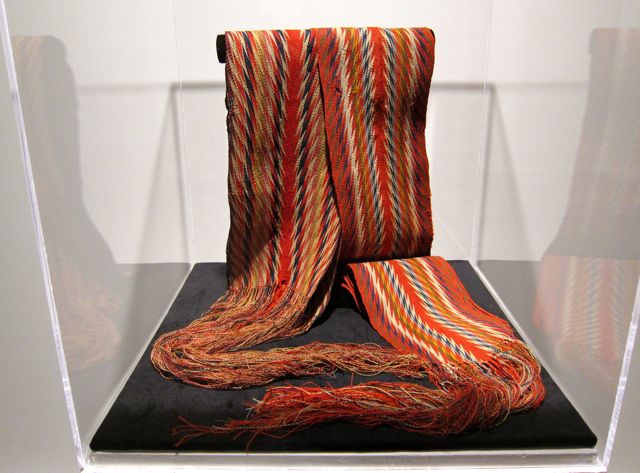
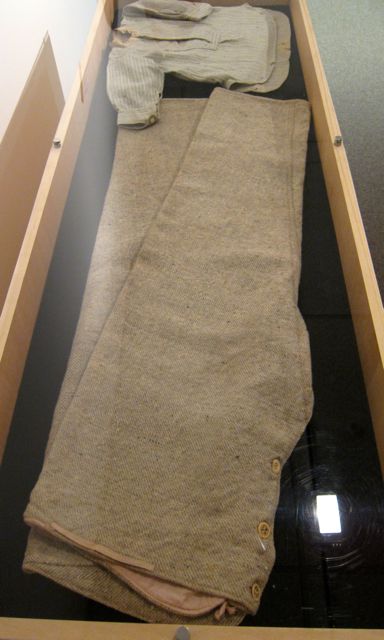
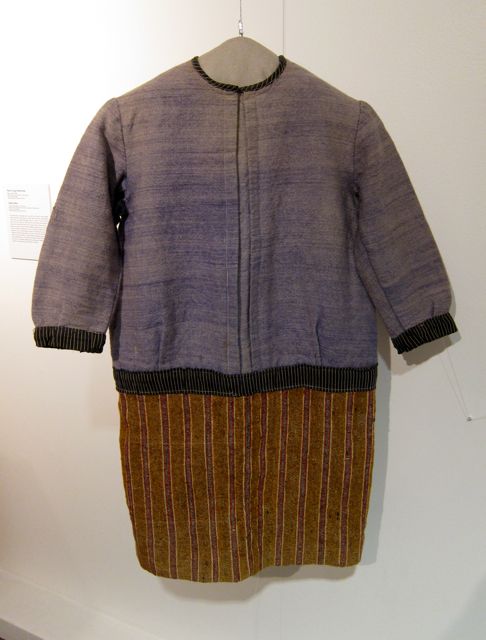



Recently, I was asked to contribute a guest post on the topic of delivering excellent library service. The post can be found here on the TPL website devoted to their Strategic Plan.
 Life Within, Catherine Raine, 2012
Life Within, Catherine Raine, 2012
I made this collage for a friend who has been fighting a life-threatening illness. When I asked her what colors, images, and themes she might like, she wrote, “I have been enjoying vivid colors lately, and anything that evokes the ocean. We spent two weeks in Hawaii before my surgery, and images of the water and life within helped carry me through . . . . Themes of time, stretched and compressed feel relevant.”

Life Within, Catherine Raine, 2012
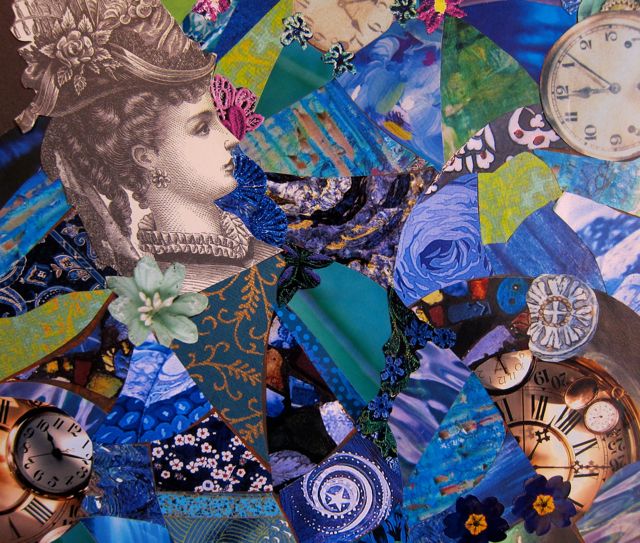 Life Within, Catherine Raine, 2012
Life Within, Catherine Raine, 2012
 Life Within, Catherine Raine, 2012
Life Within, Catherine Raine, 2012

Ever since a friend introduced us to the northern beauty of Elliot Lake and its surrounding forests two years ago, my husband and I have taken several trips there. After our first visit, I even wrote a blog post about Elliot Lake’s library situated in the Algo Centre Mall.
On June 23, 2012, part of the Algo Centre’s roof collapsed, crashing through two floors of the mall and killing two women. The news shocked and disturbed me, especially when I considered how often we had shopped in this building and how my friend used to spend countless hours in the food court working on her laptop. Before the mall collapsed, my faith in the safety of structures like the Algo Centre was intact, but now that conviction feels shaky.
Earlier this year, my husband and I had discussed another visit to Elliot Lake at the end of the summer. After the tragedy, we weren’t sure if we still wanted to go, but in the end we stuck to our original plan in hopes that our tourist dollars would help the community.
 On a hot afternoon last Saturday, Stewart and I lunched at Jane’s Tea Garden, a cafe and gift shop that faces the fenced-off hill that marks the edge of the Algo Centre’s property. As I ate my soup and salad, I saw at least eight people, some with large cameras, climb up the stone steps that stopped abruptly at the tall fence bordering the mall and its parking lot.
On a hot afternoon last Saturday, Stewart and I lunched at Jane’s Tea Garden, a cafe and gift shop that faces the fenced-off hill that marks the edge of the Algo Centre’s property. As I ate my soup and salad, I saw at least eight people, some with large cameras, climb up the stone steps that stopped abruptly at the tall fence bordering the mall and its parking lot.
After lunch, I bought a pair of sneakers from Tin Can Alley (a few doors down Ontario Avenue from Jane’s Tea Garden) and then walked up the stone steps that the other tourists had recently ascended. I stopped in front of the “Danger! No Trespassing” sign and looked beyond it to the ruin of the mall. It didn’t seem right to snap photos of such devastation, so I left my camera in my bag.
I felt a little queasy from the heat and the way the twisted metal and concrete debris reminded me of the fallen Twin Towers and pictures of Joplin, Missouri after last year’s tornado. Nevertheless, I wanted to get a clearer view of the collapsed mall entrance, so I walked a few paces west.
I tried to take in the scene in its entirety, but it was difficult. My eyes kept locking on stray details like the five shopping carts I could see in the foreground and closer to the entrance. It was like a grim game of I Spy:
I spy one of the carts fallen on its side and another one full of thick silver wires pulled from the rubble. Two more carts have been tossed into piles of debris in the parking lot, and the last one I see is upright and empty, a ghostly reminder that this place used to be a busy, normal site of commercial activity.
When I look at the carts, I remember buying a purple paisley blouse and two towels from the now silent Zellers two summers ago. I used one of the towels to pad an epic sprawling-on-a-dock session by a lovely lake, one of my favorite memories of northern Ontario. And the Foodland where we bought picnic supplies — apples, petite boursin, juice boxes — is now a reeking horror of rotten food that has had two months to putrefy.
From my position upwind of the grocery store, I was spared the revolting smell, but I still felt slightly nauseated and shaky. The disaster site put me off-kilter, and a vague sweaty headache pulled at my consciousness. In my gut, I sensed a pocket of emptiness in the shape of a fist. The fist was the color of hot rust, its knuckles outlined in red.
Although I didn’t personally know the two women who died in the collapse, the tragedy of their passing exposed my own grief over recent and past losses, for the presence of Death collapses identifying boundaries such as the cause of death, the location, the time elapsed, and social proximity to the victims. The people who lost Doloris Perizzolo and Lucie Aylwin two months ago at Elliot Lake are hurting like me when I lost Dad, Grandma, Jenny, and Eric.
Looking past the rubble to the mall itself, I was struck by the naked chaos of the twisted, ragged hole where the mall’s entrance used to be. I looked at it in disbelief and wondered if I should be witnessing a building in such an exposed condition. Maybe that was why I didn’t feel right taking pictures of the ruin. The mall looked vulnerable, literally stripped to its bare skeleton, showing square frames upholding nothing save a few exposed wires where solid walls once stood.
The entrance was a peeled and ragged maw of emptiness, a grimacing face on which silence rests because nobody knows what the hell to say. And behind that useless portal lay a crime scene, its rotting contents a nauseating metaphor for the neglect that led to the collapse. A traumatized and traumatizing building with memories of shock, fear, flight, injury, and death.
I think about the library on the second floor of the mall. It wasn’t far from the lottery booth where the two victims died. I remember the quilt on the wall, fishing rods for rent, a mural, and a large French collection. All part of the rubble now. (Elliot Lake plans to open a new library not far from the mall at White Mountain Academy).

 For comfort, I turn away from the ruin and walk back down the hill to study the shrine. Although it sits in the shadow of destruction, decay, and collapse, the memorial display is an attempt to lovingly respond to senseless loss. The shrine’s candles, Inukshuks, teddy bears, flowers, and angels testify to a heartbroken town’s courage, community strength, and its refusal to forget. Elliot Lake, I’m holding you in my prayers as you wrestle with grief and seek the light of justice.
For comfort, I turn away from the ruin and walk back down the hill to study the shrine. Although it sits in the shadow of destruction, decay, and collapse, the memorial display is an attempt to lovingly respond to senseless loss. The shrine’s candles, Inukshuks, teddy bears, flowers, and angels testify to a heartbroken town’s courage, community strength, and its refusal to forget. Elliot Lake, I’m holding you in my prayers as you wrestle with grief and seek the light of justice.
With “Twilight,” Kathak dancer Bageshree Vaze ushered in the evening’s performances and commanded our attention by simply standing beside a tree. When Vineet Vyas began playing the tabla drums, the dancer’s head, torso, and straight legs seemed to act as an axis, a communicative mediator between the sky, the music, and the land.
Suddenly Vaze’s right arm curved up and left arm curved down, and the full swoop of her arms made one continuous shape. A tilted seabird with its wings fully extended, the left one pointing to the earth.
Soon Vaze joined the tabla musician on a square of plywood resting on the grass. I liked the way she listened to the drums with her entire body and responded with articulate arms, hands, and fingers.
Ms. Vaze’s expression was amused but dignified, joyful yet contained within the ancient cool of Kathak. When she held her arms wide, they defined a momentary world that contained her dance, the drums, the plywood, the trees, the audience, and the darkening sky. Although it was her hands that held two votive candles at the beginning of “Twilight,” it was her entire self, her dance that made the offering.
The dance picked up speed, and the artist’s soaring arms seemed to direct the traffic of night spirits and fireflies. She picked delicate, easily-bruised fruits from a twilight orchard, her elegant mimes turning into a spin that made her full black skirt twirl like a dervish. Soon her movements became slower, and when Vaze’s performance ended, she raised her hands to us with her palms pressed together. Namaste.
In contrast to the solitary spiritual refinement of the first dance, “Audible” by Vancouver’s 605 Collective projected a fun and rowdy vibe. Four young dancers began the piece with the purposeful donning of arm pads, knee pads, and a red contraption that combined the elements of football helmet, trendy giant headphones, and earmuffs.
Thus armed, the group displayed athletic stamina as they performed staggered earth-dives, leap-frog leaps, lifts, and planned body-crashes that morphed into animated huddles. “Audible” captured the joy of touch football in the park before you got called home to supper. It was a Simon-Says scrum, a friendly fight enacted by playful Marines with hip-hop synchronicity and verve. By the end of the dance, the performers’ clothes were gloriously muddy, and I liked that they didn’t care.
The third Dusk Dance was Lua Shayenne‘s “Crazing,” which the program guide described as a tribute to Shayenne’s “childhood memories of living in Africa.” Four female dancers and two male drummers transformed a circular park clearing into a fiery celebration of fluid spines, wild yet precise arms, and an ease of movement that shouted Freedom!
One of my favorite moments was when Walter McLean walked forward with his dun (drum), and the four women stood together in a row behind him. They began to sway forward and back in unison as if they were in trance. Emotional surrender was beautifully embodied in the way they tipped their heads back, almost breaching their balance point, and then slowly folded their torsos forward.
At the close of “Crazing,” the women formed a living table, an intentional heap of gently swaying figures, each one’s head resting on the lower back of her fellow dancers. Stirred up by so much gorgeous movement, the long grass-like threads of the women’s skirts continued to sway as the dancers rested.
“Onward Ho, My Love” was my favorite dance of the evening. Choreographed by Julia Aplin, it featured an imaginative set and two gifted dancers, Yvonne Ng and Robert Glumbek.
Spread on a long flat stretch of open grass was a homemade slip-and-slide strip. Above it was a trellis dripping with fairy lights secured to some tree branches. Hanging from the trellis were a number of large plastic bags full of water. The remaining props included two buckets and a self-service curtain that the dancers simultaneously held up and walked through at the start of their funny and charming performance.
The pair danced, lilted, argued non-verbally, waltzed, flirted, and played with each other up and down the length of the plastic-covered red carpet. The comedy of “Onward Ho, My Love!” expressed itself in Glumbek’s red striped union suit, tuxedo jacket, and top hat as well as the perky French music, the cheeky lifts, and even the pair’s dramatic height difference (Glumbek looked like a graceful giant next to the petite Ng).
I loved the moment when Glumbek began poking the first bag of water with a stick and then stood under the resulting shower in a mock sulk. Meanwhile, Ng went to a bucket and took out a pair of goggles and some slippers. Soon, to our delight, the couple were sliding crazily on the wet strip of ultimate slipperiness. By this time, Glumbek had also put on his sliding gear, and the water battle escalated. Ng splashed the contents of the silver buckets on the slide and in response her partner poked more holes in the remaining overhead bags. Exhilarating mayhem ensued as the audience cheered.
I’m pretty sure every single one of us in the crowd wanted to hurl ourselves on the slide and join the fun, but perhaps it was enough to be in the presence of such uninhibited creativity and playful sexiness. If the dancers gave themselves permission to have so much fun, why couldn’t we do that too?
By the time the last performance began in the northeast corner of the park, I was feeling exhausted and reaching sensory overload, so I wasn’t able to give “Crepuscular” the attention it deserved. However, I liked the cage-like mesh box that served as a dance container for one of two male dancers as well as a screen for projected images of darkest night, fairy-tale transformation, and primal fear of wolves.
Once the movement began, there was a lot of crouching, turning, meeting, and separating. My attention was wandering, but when a dancer approached the side of the box, leaned far back and raised one thigh up, it made an impression on me. I don’t know if the thigh was saying defense or surrender, but it woke me up nevertheless.
Some commentary from a young child in her mother’s arms was entertaining as well. She kept asking, “Why is there a man in a box? Why doesn’t he come out of the box?” She also observed, “They’re just dancing around.”
I’m not sure if the critic-in-arms was suggesting it was time for the “Crepuscular” dancers to find a new activity, but for my part I was happy to head back home after having witnessed so much uplifting dance in Withrow Park.

Intrigued by the opportunity to learn about Gaga dance, I arrived at Parkdale Library just before two o’clock. Three volunteers in Luminato festival T-shirts guarded the staircase leading to the program room below and checked off names from a list of 60 registered participants.
This was a very special program, for members of the renowned Batsheva Dance Company were coming all the way from Israel to share the Gaga technique with Toronto.
After my name was ticked and my wrist stamped, I went downstairs to a room in which grooved wooden dividers had been pushed back to create the largest possible amount of space. From the maps and educational posters on the wall, I guessed that the space was usually devoted to more stationary pursuits than dance, such as homework clubs and youth council meetings.
Due to some problems with traffic, the Gaga dancers were about ten minutes late. This gave me plenty of time to observe my fellow participants. Eagerly gathered for guided movement, most of us lined the edges of the room, but four movers put themselves out on the floor. One made a starfish shape, sprawling comfortably in lavender socks, her form not confined by the large white square tiles of the floor. Another person executed a series of energetic stretches while a nearby lady rolled from side to side on her back. A middle-aged man in shorts walked slowly across the room in a straight line, rising up on his toes at regular intervals.
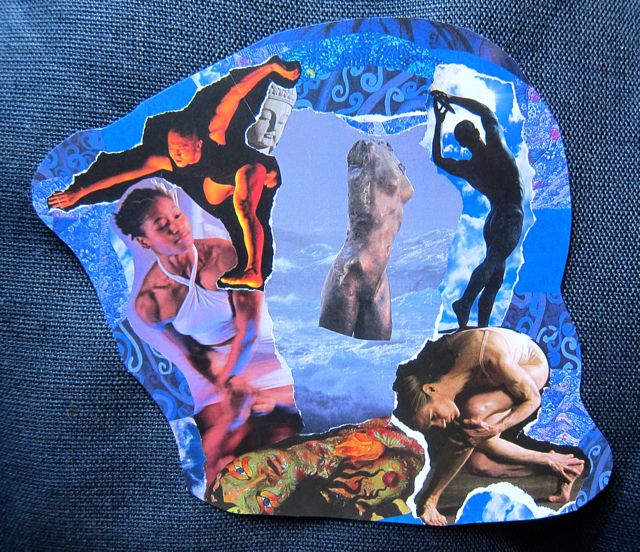
I appreciated the diversity of age, gender, ethnicity, and body sizes in the group. As a tall and robust 43-year-old woman, I was initially worried that I’d be an elephant among dancing gazelles. I had even considered bailing out earlier in the day, but I am so glad I didn’t!

Among the gathering, I noticed a lot of Lululemon clothing and yoga-straight backs, feather earrings, gym bags and souvenir T-shirts from marathon events. Also present were jeans and ballet slippers, water bottles and bike helmets, rainbow socks and pedicured toes.
If dancers find themselves in a room with nothing to do for ten minutes, they usually default to stretching. At the Gaga Dance Workshop, the assembled movers twirled their ankles, performed unbidden leg-lifts, and engaged in hip and shoulder stretches. Some made more expansive movements, swinging their arms and legs like elegant pendulums. Unsure what the next hour might bring, many prepared all parts of their bodies for possible engagement. Accepting their wisdom, I sat on the floor and stretched forward, wishing I could touch my forehead to my knees like the guy next to me.
When Rachael Osborne, our dance facilitator arrived at 2:10 p.m., she asked us if this was the class for dancers or non-dancers. Somebody assured her it was for the latter, and she laughed and said, “But I see a lot of dancers here!”
I liked how Rachael launched right into the program without preliminary talk. She invited us to spread throughout the room and to contemplate the way that gravity was affecting our bodies. She encouraged us to increase our awareness of how our bodies exist in space, the distance between our arms, the temperature of the air on our skin, how our clothes feel where they touch us, the way our bones stack upon each other, and the feeling of our inner and outer flesh.
“Think about the inside our your bodies. We often don’t know what’s going on in there. Imagine channels and highways flowing throughout you, sending important information. Picture the energy, heat, and juices flowing through these channels. Keep these highways open.” Later, she exhorted, “Keep the box of your chest open so that it’s no longer a separate rib cage box disconnected from the surrounding flesh.”
As a group, we experimented with expressing the sensation of our flesh and bones floating in water and then in the thicker liquid atmosphere of honey. “Don’t be a victim of gravity. It ages us.” Then we followed Rachael’s example as she demonstrated port de bras and asked us to imagine our entire outstretched wingspan as being one long rope, not two separate right/left binary limbs.
“Your spine, let it flow like seaweed. We also call it the ‘snake of the spine’ in Gaga.” Rachael reminded us that our neck is an extension of our spine and that our head is also composed of flesh and goo. (My inner Midwestern Puritan grew squeamish at the juicy way she kept repeating the word flesh).
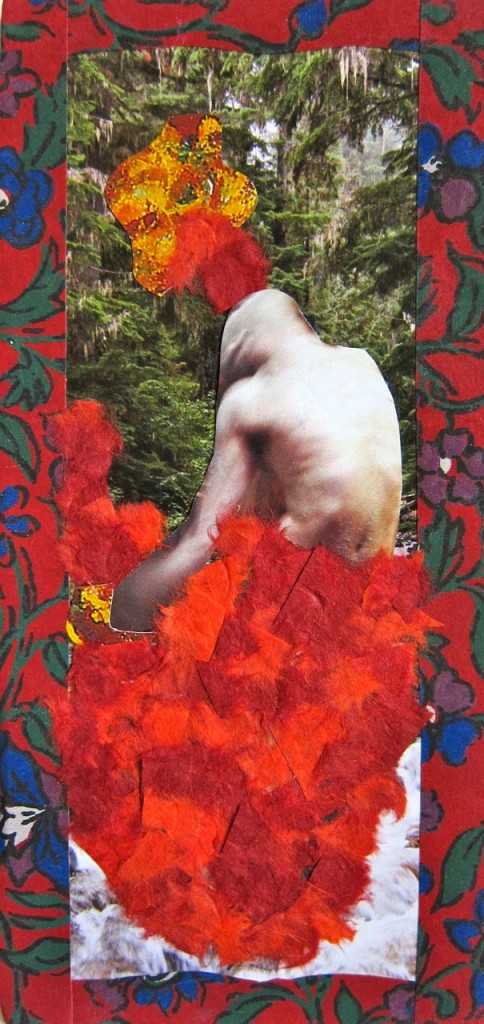
As the hour flew by, we pulled the rope of our arms across the spine, articulated our shoulders and arms with palms up and palms down, challenged our hips with figure eights, walked with a groove, and cultivated a quake in our pelvises that translated into full body quakes. For our final movement exercise, the quakes that begin in the core quickly began to shake legs, torsos, shoulders, arms, hands, and heads.
Sixty people grooving and quaking around the room was an unforgettable sight, and I’m so grateful I got to be part of it. Thank you Rachael, Parkdale Library, and Luminato for this revelatory experience!
Introductory note: I wrote the following article during my tenure at the Canadian Centre for Victims of Torture from 2004 to 2010. For the last few years, I’ve been thinking about finding for a home for this reflection on trauma and learning, but in the meantime there are some insights that might be useful to teachers and administrators who work with refugees. That’s where the accessibility of a blog comes in handy! At 2773 words, the essay is much longer than my usual posts, but I hope you enjoy it regardless.
Trauma, Learning, and the Supportive Classroom
by Catherine Raine
Inspired by more than six years of teaching LINC at The Canadian Centre for Victims of Torture, I would like to reflect on trauma’s effects on learning and the need for a supportive class atmosphere.
I. Trauma and Learning
Trauma survivors bring grief and loss with them to class:
“Death is better than life, teacher.”
“Life is zero.”
“I’m waiting for death.”
“My whole life is pain. It’s better to die.
“Learning English is so difficult at my age. As they say in my country, ‘Death is the golden lid.'”
However much I hope that the worst is behind my students, for them trauma continues in the present tense. For instance, a new loss can set off an avalanche of grief when relatives die far away, triggering agonizing memories. During my time at CCVT, at least six of my students have lost mothers, a father, a sister, and a nephew. In the last case, my student’s 28-year-old nephew had been murdered for protesting against the regime of his native country.
Fresh losses, suicidal statements, and depression are realities in my classroom. In terms of low mood, I find that Mondays are the most challenging days. With no classes scheduled on Fridays, by the time Monday arrives, the learners have had three full days to sink into their private glooms and preoccupations. On Monday mornings, it’s very difficult for them to rise out of their individual “sloughs (of) Despond” (Pilgrim’s Progress part 1, page 12). Insomnia, poor concentration, and low self-esteem accompany and reinforce students’ low spirits. I often hear:
“I can’t remember the words I learned.”
“I’m too old to learn.”
“I learn fast but then I forget everything fast.”
“I can’t speak English.”
In fact, self-perception of poor language skills makes them feel even worse about themselves. Many are highly critical of their English ability and have low tolerance for making mistakes, refusing to give themselves permission to be “wrong.” Moreover, there is extreme sensitivity to correction. For example, one time a man got angry when a female classmate pointed out a spelling mistake that another classmate had made when writing a sentence on the board. Interestingly, the actual writer wasn’t upset about the correction, but the angry student had been brooding for a month over a critical remark made by the same female student. In my experience, most students will accept a gentle correction of grammar, pronunciation or reminder to listen from the teacher, but they resent a fellow student taking on this role.
Thankfully, harmony prevails in class the majority of the time, despite personality clashes here and there. The only time I needed to intervene over potential physical conflict was when two young women playfully pushed each other as they both reached for the same picture of a lion during a collage exercise. Though they assured me they were “only joking,” I told them to stop. When the behavior repeated itself a few weeks later, I said, “I need you to stop that. I’m serious.” I don’t like play-slaps in class because they undermine the safe, stable atmosphere our students need. Mock tussles can lead to real fights. And worst of all, they send the message that violence is an acceptable way to express anger.
Prompt and assertive correction of inappropriate classroom behaviour is crucial because CCVT students are very sensitive to issues of fairness. It reassures them when authority figures don’t ignore aggressive words or actions, for many of them have suffered from the rule of bullies. With problems such as lateness, I try to remind every latecomer why it’s important to get to class on time. And if a student is extremely late, they don’t receive their full TTC token allotment for the day. Use of this measure has to be consistent because the students are so keenly aware of justice. They watch and remember. And they have the potential to become extremely upset if they feel singled out for “criticism” when others go unchastized.
Not only are CCVT learners extra-sensitive about personal justice, they are also hypersensitive to expressions of anger by the teacher. Victims of torture and abuse become very skilled at reading moods, a protective defense against the unpredictability of tyrants (Trauma and Recovery, page 139). For this reason, I try to greet my students enthusiastically, even when they are late, and then keep my tone gentle when I call attention to issues related to punctuality, being respectful to classmates, and loud talking in a first language.
The rare times I have gotten visibly angry, I always regretted it afterwards. Gentle correction and reasoning work better, especially for sensitive students like the one who once said, “You’re gonna kill me!” when she kept yawning while trying to ask a question during a reading lesson. I laughed and said, “No, I’m not going to kill you, but I don’t know how to speak yawn!” On another occasion, I received a startling reaction when I slightly leaned over a student’s desk to point out something on his handout. He cringed and recoiled as if I had raised a hand to hit him. I’ll never forget his haunted expression, the face of someone who expects to be beaten for no reason.
II.The Supportive Classroom
CCVT clients have unique learning difficulties, but that doesn’t mean they are impossible to overcome. I have found that building a class community, cultivating a welcoming atmosphere, and employing supportive teaching methods can provide hopeful and restorative measures to counterbalance the negative effects of trauma.
The foundation of any class is a strong, positive relationship between each student and their teacher. This foundation also includes a feeling of solidarity and bonding between classmates. We sometimes have birthday parties for the students, which helps bring us all closer. Yet even these celebrations can be bittersweet. I once asked the class if there were any birthdays in January, so we could make plans for the next party. A young woman responded, “Not a birthday, but the anniversary of my husband’s death.” Such heavy grief cannot help but surface at the mention of yearly rituals, the painful annual reminders of lost loved ones, including birthdays no longer celebrated.
I strongly believe that one of the purposes of CCVT is to correct the balance of loss in some small way, to create new friendships that caulk the scars of lost loves, lives brutally stolen. Nothing can replace entire personal worlds dissolved forever, but new stories and new relationships can partially refill the emptiness that follow survivors wherever they go. For instance, a lively Somali woman received her Canadian citizenship three summers ago, and we had a wonderful party in her honour. Two tables supported a pot of rice, pans of vegetables and meat, homemade bread, pastries, chocolate cake, and three big bowls of chocolate ice-cream. The entire student body was talking, laughing, and dancing, and it felt good to be connected to a community, laughing and leaping in celebration of our new Canadian. Her happiness was contagious and I felt so proud to be part of the new life she is building in Canada.
A few months after the citizenship party, we did a Thanksgiving exercise in which each student told the class what they were thankful for. A great number of them said, “I’m thankful for my class and for CCVT.” Their sincere gratitude impressed on me just how much our LINC class means to the clients. It is much more than a place to study verbs and vocabulary. Our students come to be with their friends and to create meaning in their lives after the experience of senseless violence.
A stimulating class can be a place to forget past and present troubles. Many of my students are primary caregivers for either young children or ailing elderly spouses. For them, class is where they go after dropping three kids off at day care or taking a husband to the hospital for dialysis treatment. I try to keep students’ outside responsibilities in mind when I’m planning my lessons because I really want them to enjoy their hard-won time in class while they learn some new English vocabulary, a grammar point, or a useful fact about Canada. For these caregivers and indeed for all the students, a lively yet stress-free class motivates them to come regularly. Our frequent laughter cheers all of us up and creates more togetherness. With so many duties and troubles, my students often need a really good laugh. As one of them once told me, “A lot of us come to class and can only half pay attention. Some have trouble at home, thinking too much, others worry about money, their families, many things.”
Games such as Bingo are a refreshing antidote to serious grammar lessons, and to add further interest I like to provide small prizes. Even though a pencil, a travel size bottle of lotion, or a piece of candy has little monetary value, the social currency is high because the prizes increase motivation as well as create a stronger bond between students and their teacher (everybody gets a prize). The gifts could even be regarded as a positive “transitional object” (Trauma and Recovery pages 150, 152), reminding the learners that their instructor cares about them even when she’s not physically present. Lately, I’ve been offering selected books from Toronto Public Library book sales as prizes, and the students really appreciate receiving books on spelling, science, gardening, world religions, and grammar.
To further build educational and social support for the students, we occasionally leave the classroom to venture into the city and beyond. Field trips are especially beneficial for some of our learners who rarely leave their homes except to go to CCVT, work, or No Frills. Some may lack a social network and others are inhibited by language barriers or financial constraints. It does us all good to break out of routine and visit the Royal Ontario Museum, the Art Gallery of Ontario, the National Film Board, the CN Tower, Casa Loma, and Allen Gardens. Sites of natural beauty that have soothed us include The Toronto Islands, Niagara Falls, The Beaches, High Park, and the Harbourfront. In addition, class discussions of politics and world events have been made more concrete by visits to Queen’s Park and joining the Refugee Day Celebration at Dundas Square every June.
Finally, outings to the Parliament Library and Toronto Reference Library have reinforced independent study skills and given me the opportunity to guide students towards learning materials geared to their individual needs. On a personal note, I get a studious thrill out of all the new library cards issued and books checked out. A new library card is very meaningful because it represents independence for newcomers, especially for some of the women who don’t necessarily think in terms of having their own card in their own name. Tucking a shiny blue card into your billfold is also one more positive step towards that accumulation of identity that adds up to settlement in a new country. Many of our students need this affirmation and that extra nudge just to fill out the library membership application form. In the words of a student: “When you’ve been a refugee and haven’t lived a normal life for five years, ten years, then little things become big.” Just mustering the energy to get a library card can seem overwhelming, so whatever CCVT can do to make their lives more normal, stable, and coherent is very welcome.
The need for stability after so much uncertainty guides the structure of our classes at CCVT. That’s why the teacher’s punctuality makes a big contribution to creating a reassuring routine. Our students have experienced a lot of limbo as well as worry about the welfare of others. There have been times when I was delayed by five minutes, only to enter a classroom where the learners were wondering aloud what happened to me. Punctuality not only comforts the students, but it also testifies to a seriousness of purpose that builds stability. Being on time shows that I want to be there with them and that I am committed to teaching. The learners also appreciate homework and efficient time management, as both signal a strong concern for their learning and progress. A student once gave me some helpful feedback along these lines: “I like how you start the lessons early and don’t waste time.”
Even though many of my students struggle with tardiness (due to insomnia, depression, family responsibilities), I strive to start class on time for the sake of those who have arrived early. As latecomers arrive one by one, I greet them, give them the papers, and continue with the lesson. This practice emphasizes that class doesn’t stop because of the unpredictability of outside factors. Individuals may be late, but that doesn’t mean that they are allowed to undermine or disrupt our central purpose, which is to learn English.
Asserting the primacy of class structure and clarity of focus is a vital part of building normalcy, routine, and predictability for our students’ sake. I believe this is essential for rehabilitation. Both before and after they came to Canada, CCVT clients’ lives have been disrupted by chaos, uncertainty, instability, limbo, loss, and lack of control. Many have had to abandon their education, their dreams, and their goals because of war. They need CCVT to be there for them, to not be bombed, shut down, destroyed. They need to believe that they can continue their education without disruption or abandonment. For all of these reasons, their LINC class should ideally be an oasis of calm and stability, a place where they know what to expect from the schedule, their teacher, their classmates and the curriculum.
Repetition and reinforcement are essential tools to integrate learning into a stable framework. I like to introduce new topics, grammar concepts, and vocabulary by linking them back to previous lessons. Homemade flashcards are especially useful for repetition and review of grammar points, Canadian history facts, Canadian geography, and general citizenship questions. What’s rewarding for both myself and the learners is when they realize how much they have retained. After hearing “I can’t remember anything” so many times, it’s a joy to contradict false beliefs about the inability to learn. I have one student in her late fifties who frequently gets mad at herself for forgetting words, but when I ask the class questions about Canadian history or geography, she’s often the first one to answer correctly.
I believe my students appreciate repetition for its own sake and also for the patience it implies. I strive to be very patient with mistakes because there’s so much sensitivity to correction. That’s why I monitor my tone when I point out grammar and pronunciation errors. My tone needs to be gentle so they understand that mistakes are allowed and do not deserve anger or punishment. I also hope that this gentleness will influence them to be less hard on themselves and each other when they get a word or grammar structure “wrong.” A number of my learners have told me how much they appreciate this approach. Some of their feedback includes:
“You have a different way. You teach us side by side and go slowly. Your way is beautiful. You understand maybe how to work with people at CCVT.”
“You gave us confidence to speak.”
“I like your easy-going attitude, how you are patient but don’t treat us like kids.”
Another student wrote: “Teacher I appreciate your patience and your teaching method . . . I never forget your smile and your strength.”
Drawing these observations to a close, I want to say how privileged I feel to be part of CCVT’s learning community. Every time my students walk through the door, I want to applaud the human spirit. Even though they often say they’re too old, too tired, or too depressed to learn, they come anyway. Their presence is a testament to their courage, and their story celebrates a series of personal victories over trauma to which this article has given testimony.
I’m fresh home from an afternoon devoted to poetry! Facilitated by spoken word artist, Andrea Thompson, the workshop combined a writing exercise, performance, and discussion. Ms. Thompson had a warm, engaging presence that put me at ease, and I appreciated her genuine passion for poetry.
To give us the flavor of her work, Andrea performed three of her pieces, transforming our group of twelve into a fascinated audience. I especially loved the way she sang some of the words when she felt called to sing. She brought a melodic and dramatic quality to her poems that made a big impact on me.
After we introduced ourselves, Andrea invited us to write a four-line poem based on a simple exercise. Each line was to start with the line “I am from” and then fill in the lyrical blanks with the name of a food (line one), a family or cultural tradition (line two), a snapshot of a location (line three), and something about the climate (line four).
I enjoyed listening to the poems that my fellow participants created, and many of their words have stayed with me: sandalwood, honey, dinner at five a.m., stars, land of Buddha, sound of flowers, and the promised land. To our amazement, the writer of a beautiful poem about grief said, “This is the first poem I have ever written.”
When my turn came, I noticed some constriction in my breathing, but I was able to read the following lines to the group:
I am from pecan pie, treacle sweet, tasting of Midwestern corn syrup and warm Southern trees.
I am from total immersion baptism by the old pastor in his Brooks Brothers suit.
I am from Liberty, Missouri, the buckled up Bible belt, green and friendly, with undercurrents of despair.
I am from tornadoes, sirens that shoo us to the cellar, staring at the cold rust on the freezer.
I am from there.
As I write on a slightly rickety table beside the snack cart, I’m enjoying the shade and moving shadows of a tall tree. The same waving branches that are making patterns on these pages recently hosted a rock pigeon, but it has flown away.
I’m taking a rest after almost two hours of desert trail-walking. Funny how the landscape didn’t really reach me at first, but before long I lost my heart to its wildflowers, lizards, hummingbirds, and flowering cathedral cacti.
As I made my way along the Desert Wildflower trail, the Desert Discovery Loop, and the Steele Herb Garden, fragments of lectures and conversations shimmered briefly, the fluttering of unseen wings in the leaves.
Tap Root.
Burrow.
Nest.
Lizard!! Lizard!!
“Would you like a picture of this cactus for your power point presentation?” (Father to his young son)
In the Desert Garden, I saw a multitude of memorials on benches, chairs, fountains, trees, and walls. There were even memorial drinking fountains (a lovely idea). However, I was looking for a special one, a plaque in memory of a Toronto friend’s beloved parents. And when I finally found it, I felt connected to my friend’s family and their shared memories of the Garden. It didn’t seem to matter that I never met them. They had walked these paths before and enjoyed the beauty that I was seeing.
I studied the plaque for a long time, growing sad and thoughtful. But the more I reflected on the inevitability of loss, the more I felt strangely comforted at the thought of all the people who will visit this gorgeous sanctuary long after I have had my mortal turn. The Desert Garden is an embodiment of faith, for in this place, love, memories, and the creative earth continue to flower and flower, tapping deep roots of Beauty that do not die.
I’ve reached the point in my library blog talk where I have invited the audience to create a post with me. A few minutes ago, there was mention of refreshments, so I’m also thinking about the possibility of tea and Dad’s oatmeal and chocolate chip cookies. My audience is eligible for these refreshments because they love libraries and came out to hear the talk.
Here are some of their impressions and memories of the Toronto Public Library:
“I’ve been coming here with my young children for thirteen years. We love sitting by the fireplace and reading, especially in the winter. It’s very cozy. My daughter is sitting out there by the fireplace right now.” (Dawn)
“I’ve been coming since the original structure was still in use. I remember the Taylor House. On the far side, there was a round conservatory. That’s where they had the mystery books and the stained glass window at the top of the stairs. When the new building was built, they installed the original stained glass window. This branch is a memorial branch and will revert back to the Taylor family if the library doesn’t have enough funds to sustain it.” (Heather)
“If it wasn’t for my great-grandfather, I’d never be a librarian. He lived across the street from Locke Library. He never had a chance to get an education, so the library was very important to him. When I was nine, he said to me, “You like books. You should be a librarian.” (Andrew, Librarian-at-Large)
“My grandson Cy and I visited 90 TPL libraries so far. His favourite is S. Walter Stewart. I like it because there are 10 A. Y. Jackson oil paintings there. I like libraries for different reasons. I love the panels at Dufferin/St. Clair that they uncovered. I’m also fond of Beaches. I worked there for 19 years. One of the squares on the community quilt there is mine.” (Darlene)
“It was my first job and my only job.” (Despina)
“The garden (at Taylor Memorial) was a joint effort between Maureen and me (Sally). We met at the afternoon book club. She designed the garden. The library bought some shrubs, but most of the plants were donated. It’s nice because we have a patio. Lots of people sit out on the patio with their laptops and books, enjoying the fresh air. We have tea and books there in the summer. Sometimes the authors join us as well.” (Sally)
“The Thursday evening book club is one of the longest running book clubs in Toronto. It’s been running since 1991. This club has read approximately 200 books. Heather was one of the original members.” (Heather and Despina)
It has been a true pleasure to gather these stories from my attentive and knowledgeable audience. I asked if I should add “good-looking” to the description, and Sally said, “Why not? This isn’t television!”
I’m tickled pink to be part of this April’s Keep Toronto Reading Festival. My contribution to the literary celebration will be an illustrated talk about the very blog you are reading now, Breakfast in Scarborough.
The presentation will describe my pilgrimage to all 98 Toronto Public Library branches and what I saw and experienced along the way. I’ll provide some background information about the origins of the blog, present selected pictures, and then create an interactive post with the audience on the spot.
My hope for this talk is that it will encourage TPL library patrons to venture beyond their home branches and discover the beautiful diversity that the entire system has to offer.
On a more personal level, I also aspire to be an example of what can happen when you ignore the inner critic who says things like, “Get a life, nerd! Nobody will read this obscure blog!” If I had listened to that voice, I would never have had the pleasure of proving it wrong.
Breakfast in Scarborough has now enjoyed over 17,000 views, and I have been interviewed by The Toronto Star and appeared on Matt Galloway’s CBC Metro Morning radio program. Hooray for nerdy projects! May they prosper all over the land!
Yesterday I found these three treasures at Book Ends South, the second-hand bookstore at the Toronto Reference Library. The volunteers who took my seven dollars teased me about having expensive taste because two of the books I chose were three dollars instead of one!
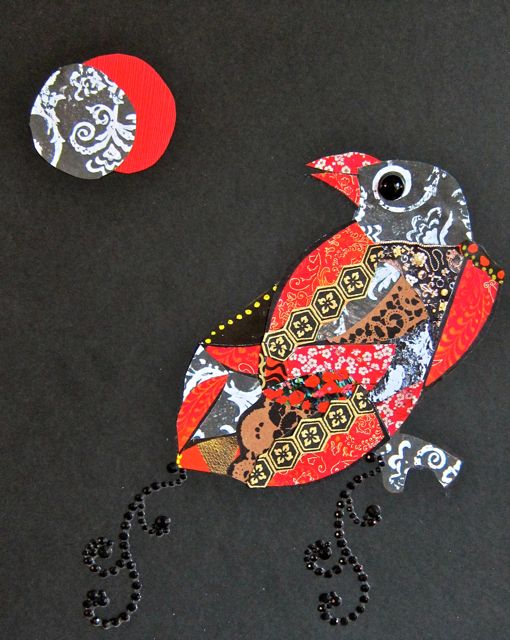 Desolate Yet All Undaunted, Catherine Raine, 2012
Desolate Yet All Undaunted, Catherine Raine, 2012
The raven is curious about the eclipse but not overly concerned. He stands his ground without fear.
 Desolate Yet All Undaunted, Catherine Raine, 2012
Desolate Yet All Undaunted, Catherine Raine, 2012
I’m sending this raven piece to an art magazine that is calling for submissions on the theme of Edgar Allen Poe. (The title comes from Poe’s 1845 poem, “The Raven”). Wish me and the raven luck!
This Russian doll is on a wild stagecoach ride to an unnamed destination!
 Matryoshka Doll on a Stagecoach Ride, Catherine Raine, 2012
Matryoshka Doll on a Stagecoach Ride, Catherine Raine, 2012
Collage materials include colored paper, stickers, and a postcard.
 Matryoshka Doll on a Stagecoach Ride, Catherine Raine, 2012
Matryoshka Doll on a Stagecoach Ride, Catherine Raine, 2012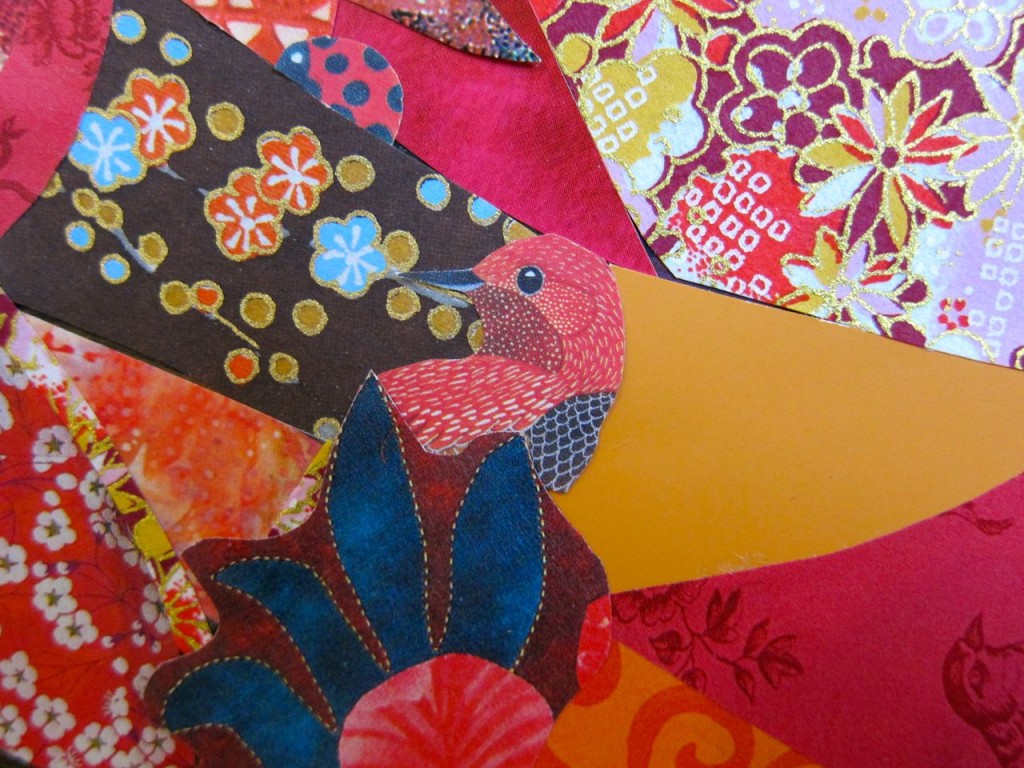 Matryoshka Doll on a Stagecoach Ride, Catherine Raine, 2012
Matryoshka Doll on a Stagecoach Ride, Catherine Raine, 2012
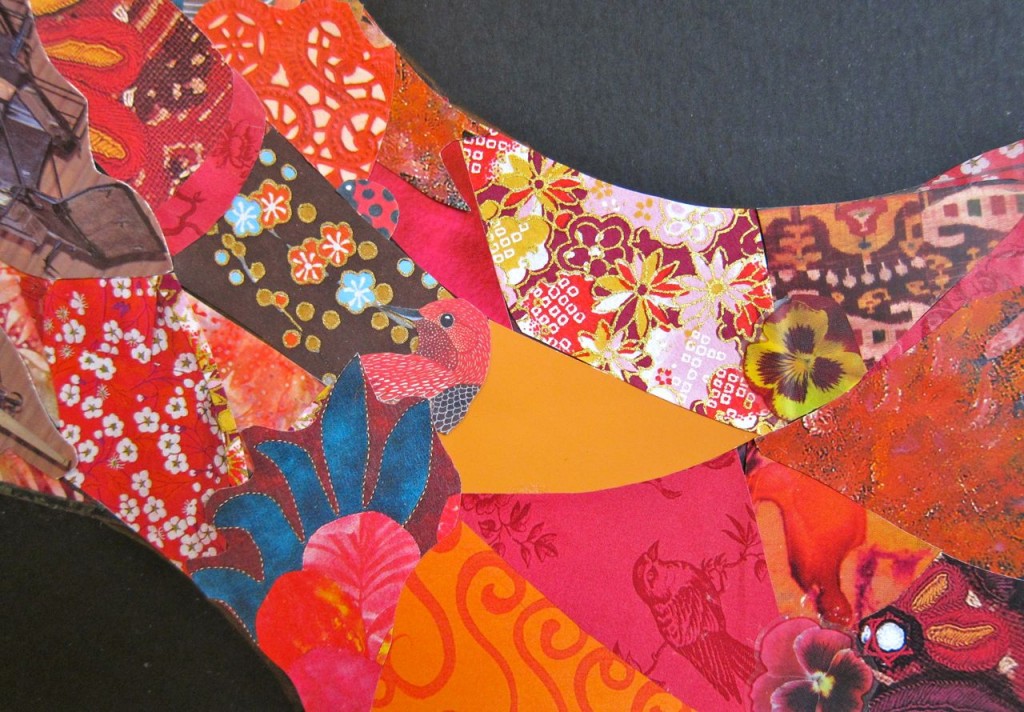 Matryoshka Doll on a Stagecoach Ride, Catherine Raine, 2012
Matryoshka Doll on a Stagecoach Ride, Catherine Raine, 2012
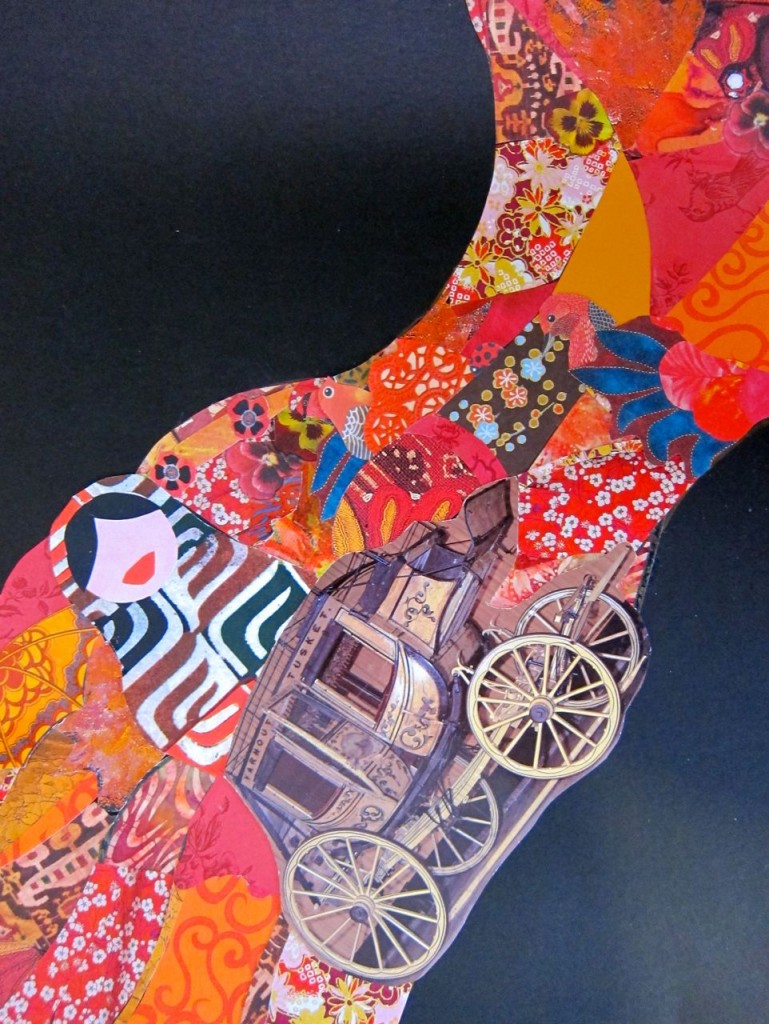 Matryoshka Doll on a Stagecoach Ride, Catherine Raine, 2012
Matryoshka Doll on a Stagecoach Ride, Catherine Raine, 2012
There she goes!